Abstract
Flax seed oil, derived from the seeds of the flax plant (Linum usitatissimum), has garnered attention in recent years for its potential benefits in hair care. This abstract provides a comprehensive overview of the properties, applications, and efficacy of flax seed oil in promoting hair health. Firstly, the chemical composition of flax seed oil is examined, highlighting its rich content of omega-3 fatty acids, particularly alpha-linolenic acid (ALA), as well as antioxidants and vitamins. These constituents contribute to its moisturizing, anti-inflammatory, and nourishing properties, which are crucial for maintaining healthy hair follicles and scalp. Secondly, the mechanisms by which flax seed oil supports hair growth and strength are elucidated. ALA, being an essential fatty acid, helps to improve blood circulation to the scalp, ensuring adequate nutrient delivery to the hair follicles. Additionally, its anti-inflammatory properties alleviate scalp conditions such as dandruff and eczema, which can impede hair growth. Furthermore, the practical applications of flax seed oil in hair care products are explored. Its lightweight and non-greasy nature make it suitable for use as a standalone hair oil or as an ingredient in shampoos, conditioners, and hair masks. Its versatility allows for easy integration into various hair care routines, catering to different hair types and concerns. Lastly, clinical studies and consumer testimonials are reviewed to evaluate the efficacy of flax seed oil in promoting hair health. Evidence suggests that regular use of flax seed oil can lead to improvements in hair texture, shine, and manageability, as well as reductions in hair loss and breakage. In conclusion, flax seed oil emerges as a promising natural ingredient for enhancing hair health. Its multifaceted benefits make it a valuable addition to the arsenal of hair care products, offering a holistic approach to nourishing and revitalizing the hair and scalp.
Keywords
Herbal gel, antimicrobials, antibacterial activity, polyherbal formulations.
Introduction
In recent years, there has been a growing interest in natural remedies for hair care, driven by a desire for healthier and more sustainable alternatives to conventional products. Among these remedies, flax seed oil has emerged as a promising c
ten labeled as virgin or extra-virgin, retains more of the coconut flavor and aroma and is typically used in baking, cooking, and skincare.
- Composition:
Coconut oil is composed primarily of saturated fats, including medium-chain triglycerides (MCTs) like lauric acid, caprylic acid, and capric acid. These fats are metabolized differently in the body compared to long-chain fatty acids found in other oils. Coconut oil also contains small amounts of vitamins E and K.
- Cooking:
Coconut oil is popular for cooking and baking due to its high smoke point and rich flavor. It adds a subtle coconut taste to dishes and is commonly used in tropical cuisines. It's suitable for sautéing, frying, and baking, and can even be used as a substitute for butter or other oils in recipes.
- Health Benefits:
While coconut oil has been touted for various health benefits, including weight loss, heart health, and improved brain function, its effects on health are still debated among experts. Some research suggests that the MCTs in coconut oil may have metabolic benefits, but more studies are needed to confirm these effects and understand how they compare to other fats.
- Skincare:
Coconut oil is also used in skincare products for its moisturizing properties. It's often found in lotions, creams, and hair care products due to its ability to hydrate and
Fenugreek, also known as methi, is an herb that is commonly used in cooking, herbal medicine, and traditional remedies. Here are some key points about fenugreek:
- Culinary Uses:
Fenugreek seeds and leaves are used in various cuisines, particularly in Indian, Middle Eastern, and Mediterranean cooking. The seeds have a slightly bitter taste and are often used whole or ground in spice blends, curries, pickles, and bread. Fenugreek leaves, known as kasuri methi, have a distinct flavor and are used fresh or dried in dishes like curries, stews, and salads
- Nutritional Profile:
Fenugreek seeds are rich in protein, dietary fiber, vitamins (such as vitamin B6 and vitamin C), minerals (including iron, magnesium, and manganese), and phytonutrients. They also contain compounds like saponins and flavonoids, which may have antioxidant and anti-inflammatory properties.
- Health Benefits:
Fenugreek has been used in traditional medicine for various purposes. It's believed to aid digestion, improve blood sugar control, support lactation in breastfeeding mothers, and boost libido. Some research suggests that fenugreek may have potential benefits for heart health, cholesterol levels, and inflammation
Hibiscus is a genus of flowering plants that belong to the Malvaceae family. Here's some information about hibiscus:
- Varieties:
There are hundreds of species of hibiscus, but the most commonly known is Hibiscus rosa-sinensis, also known as the Chinese hibiscus or rose mallow. Other popular varieties include Hibiscus sabdariffa, known as roselle or red sorrel, which is often used to make herbal tea.
- Appearance:
Hibiscus plants are known for their large, showy flowers that come in a variety of colors, including red, pink, yellow, orange, and white. The flowers typically have five petals and a prominent central stamen.
- Culinary Uses:
Hibiscus flowers, particularly the calyces (the outer part of the flower), are used in cooking and herbal preparations. Hibiscus tea, made from the dried calyces of the Hibiscus sabdariffa plant, is popular worldwide and is known for its tart, cranberry-like flavor. It can be consumed hot or cold and is often sweetened with honey or sugar.
LITERATURE SURVEY
- K.Sudheer Kuma.etal., (2016)
Cloth pouch method was done to formulate hair oil from herbal drugs Embllica officinalis, Bacopamonnieri, Hibiscus rosasinensis, trigonella foenumgraecum. All the following herbal drugs were boiledincoconutoilwhichwasusedasbaseforhairoilpreparation.Theresearchprovidesguidelineson use of herbal ingredients on preparation of herbal hair having minimal or no side effects
- Mahavir Chhajed.etal.,(2020)
Hair growth cycle is divided into phases as following: Anagen (growth), catagen (involution), telogen (rest).Decreaseinanagenphasemaycausehairweakerandthinnerinfurthercycle.Toavoidthisspecific nutrient in diet should be maintained for healthier hairs. Types of hair loss known are Androgenetic or Androgenic alopecia (baldness), Alopecia areata, Telogen effluvium, chemotherapy induced alopecia
- NS Yamani. etal.,(2018)
Polyherbal hair oil: India has variety of medicinal herbs with various cosmetics and healing properties. The herbal constituent chosen for formulating hair oil were have reported to have antidandruff property, hair thickening and hair fall controlling properties which when used together show synergistic activity and maintain hair health.
- T.Usha KiranReddy.Etal., (2017)
Coconut oil is extracted from kernel or meat of matured coconut harvested from coconut palm. In wet process coconut oil is made first and then oil is extracted form milk. Methods used for preparation of herbal hair tonic is cloth method, paste method, direct boiling method. Evaluation of herbal hair oil was done by 1) physical evaluation: specific gravity, Ph 2) chemical evaluation: acid value, saponification value 3) biological evaluation: primary skin evaluation tests.
- MdShahinoorRahamanDulal.Etal., (2014)
Methods of finding out how herbal hair oil is advantageous over plain coconut hair oil. The three phases studied to prepare hair tonic are the anagen, catagen, telogen. Selection of volunteer candidate selection and boiling method was implied to produce coconut oil. This hair is applied on hairs with help of cotton and left for period of 34 hrs to seek good results, applying it two times a week will give good results.
- K.D.Mali etal., (2017)
Herbalpreparationsareancientmethodologybecauseitsoriginisfoundinholyvedasandunaniscriptures. Herbal cosmetics are formulated by combination of active bioactive ingredients of pharmaceuticals. Neem, Amla, Bramhi, Shankpusphi, Kapur, Pudina are grinded and boiled with til oil, boiled mixture is filtered and volume is made with coconut oil. Acid value, saponification value, Ph, sensitivity tests,skin irritation tests are done for evaluation of prepared herbal hair oil.
- KolheShilpa etal., (2019)
Polyherbal hair oil was prepared from coconut oil as a base with amla, neem, hibiscus, shikhakai, maka flowers,bramhi,castoroil,etcallherbaldrugsweredriedandmixedwithcoconutoilandboiledforhalf hour and filtered with muslin cloth and evaluation tests were performed for prepared herbal hair oil.
- SapnaGautametal., (2011)
Work was aimed to formulate herbal oil for general purpose using various herbs and evaluated for saponification value, Ph, viscosity was determined and reported. This oil will help sebaceous gland to regrow hair and maintain their good condition. Natural herbs like barmhi, shikhakai, shnakhapushpi, bhringaraj, nirgundi, shatavari, amla, neem are following herbs used for hair oil preparation.
- Rahathunnisabegum etal.,(2019)
Hairoilsarehaircareformulationappliedforcureofhairdisorderssuchasbaldness,grayingofhair,hair loss, drying of hairs, alopecia. A plethora of herbs have been employed for hair treatment. Aloe vera, hibiscus,tulsi,methi,coconutoil,almondoil,Jasminflowerswereusedandgrindedboiledwithcoconut oilasabaseandfilteredthroughmuslincloth.EvaluationtestwasperformedfForpreparedherbalhairoil.
- PushpendraKumarJainetal.,(2016)
Hair loss or alopecia is common patient complaint and source of significant physical and psychological distress. Androgen are considered to be one of the most important causes of alopecia apart from variety of other factors. Emblica officinalis, bacopa monnieri, Cyperus rotundus herb were used for hair oil formulation.
- PoojaS.Banerjee etal., (2009)
Hairoilareusedforbaldnessorhairailment,aggressionofhair.Theypromoteluxuriousgrowthofhairs and are used as hair tonic. Hair oils are basically extract of herbs in base. Synthetic drug minoxidil is a potentvasodilatorappearssafeforlongtermuse.Majorstepsforherbaloilpreparationarepastemethod, cloth method, and direct boiling method and second main step is evaluation of hair oil and final step is determination of therapeutic efficacy.
- AshwiniV.Jadhavetal., (2018)
Herbal cosmetics contain variety of botanical sources which influence functions of skin and provide nutrients necessary for healthy skin and hairs. They are used like anti-inflammatory, antiseptic, antioxidant, and antimicrobial. They have efficacy and intrinsic acceptability due to regular use in daily lifeand avoid adversesideeffects with are commonly seen in syntheticproducts. Hairstructure contains of layers as medulla, cortex, cuticle.
DRUG PROFILE:
- Flax seeds
Biological name:
Linum usitatissimum
Synonym:
Linseeds
Family:
Linaceae, commonly known as the flax family

Figure 1flax seed
Chemical constituents: linolenic acid, linoleic acid, lignans, cyclic peptides, polysaccharides, alkaloids, cyanogenic glycosides, and cadmium.here's the chemical structure of alpha-linolenic acid (ALA), which is an omega-3 fatty acid found in flaxseed oil and other plant-based sources:
CH3-CH2-CH=CH-CH2-CH=CH-CH2-CH=CH-(CH2)7-COOH
This structure represents a chain of 18 carbon atoms with three cis double bonds, with the first double bond occurring at the third carbon atom from the methyl end (omega end) of the chain.
DESCRIPTION:
Flaxseed, also known as linseed, is the seed of the flax plant (Linum usitatissimum). It's a small, brown or golden-colored seed that is rich in nutrients and has been used for centuries for its health benefits. Flaxseed is a good source of dietary fiber, protein, and omega-3 fatty acids, particularly alpha-linolenic acid (ALA). It also contains vitamins, minerals, and antioxidants. Flaxseed can be consumed whole, ground into flaxseed meal, or pressed to extract flaxseed oil. It's commonly added to foods like smoothies, oatmeal, yogurt, and baked goods, or used as a dietary supplement.
Coconut oil :
Biological Source:
Coconut palm, Cocos nucifera
Family:
Arecaceae or Palm family
Chemical Constituents:
Lauric acid, Caprylic acid
CH3(CH2)6COOH
Caprylic acid, also known as octanoic acid,
Its chemical formula is C8H16O2
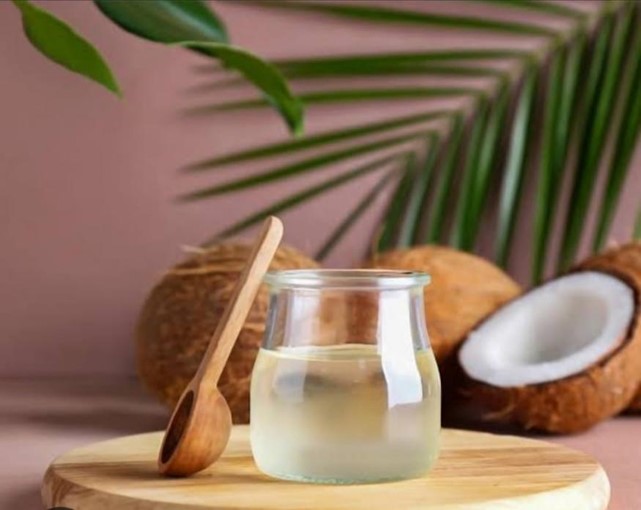
Fig no 2 Coconut Oil
DESCRIPTION:
Coconut oil is extracted from the kernel or meat of mature coconuts. It's versatile and used in cooking, beauty products, and even in industrial applications. With its high saturated fat content, it's valued for its potential health benefits and its ability to withstand high cooking temperatures. Additionally, it's used in skincare and haircare for its moisturizing and nourishing properties
Fenugreek .:
Synonyms :
methi, bird's foot, Greek hay, and trigonella.
Biological Source :
Fenugreek is derived from the seeds of Trigonella foenum-graecum.
Family:
Fenugreek belongs to the Fabaceae or Leguminosae family.
Chemical Constituents:
Alkaloids (such as trigonelline), Saponins
DESCRIPTION :
Fenugreek is an annual herb native to the Mediterranean region, cultivated for its seeds and leaves. It belongs to the Fabaceae family and is known scientifically as Trigonella foenum-graecum. The plant has small, white flowers and produces pods containing the seeds. The seeds are small, golden-brown in color, and have a distinctive, slightly bitter taste. Fenugreek seeds are commonly used as a spice in cooking, particularly in Indian, Middle Eastern, and North African cuisines.
CH3
|
H3C—N—CH—CH2—COOH
|
H
This representation depicts the pyridine ring (N-CH-CH2) with the methoxy group (CH3O) attached to the nitrogen atom and the carboxylic acid group (COOH) attached to the carbon atom adjacent to the nitrogen.
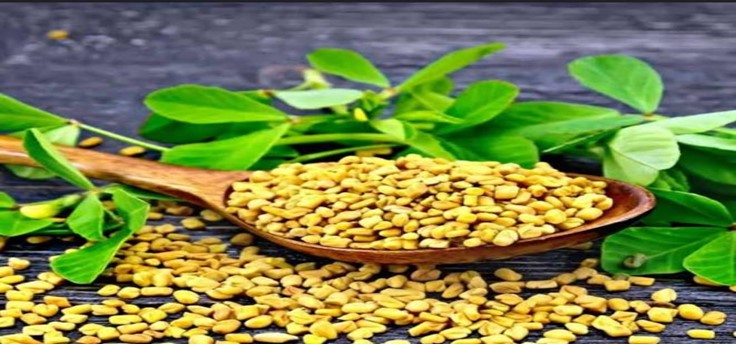
Figure03 -Fenugreek Seeds
Hibiscus flower:
Synonym:
china rose
Biological name:
Hibiscus rosa-sinensis
Chemical constituents:
anthocyanins and polyphenols
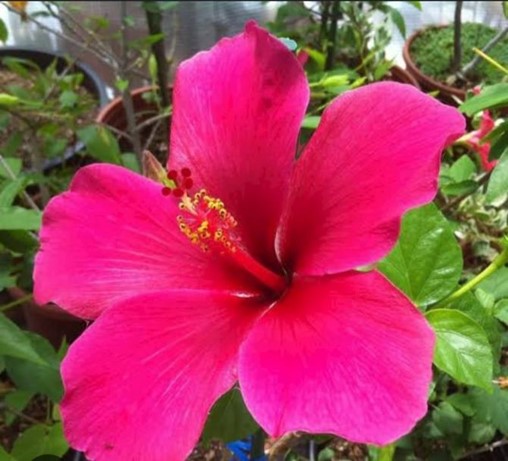
Figure -04
The hibiscus flower is known for its large, trumpet-shaped petals and vibrant colors, often in shades of red, pink, yellow, or white. Its intricate stamen protrudes from the center, surrounded by a cluster of delicate, thin filaments. Hibiscus flowers are commonly associated with tropical regions and are admired for their beauty and symbolism.
Curry leaves:
Synonyms:
Curry leaves are also known as sweet neem leaves, Kadi patta (in Hindi), or Kariveppilai (in Tamil).
Biological source: Curry leaves come from the curry tree, scientifically known as Murraya koenigii. It is a tropical to subtropical tree native to India and other parts of Asia.
Family:
Curry leaves belong to the Rutaceae family, commonly referred to as the citrus or rue family.
Chemical constituents:
Curry leaves contain various compounds, including:
Alkaloids:
Such as murrayanine, girinimbine, and mahanimbine.
Flavonoids:
Including kaempferol, quercetin, and rutin.
Carotenoids:
Such as beta-carotene, which gives curry leaves their green color.
Essential oils:
Compounds like alpha-pinene, beta-pinene, and limonene contribute to the aroma and flavor of curry leaves.
Phenolic compounds:
Including caffeic acid, ferulic acid, and quercetin glycosides
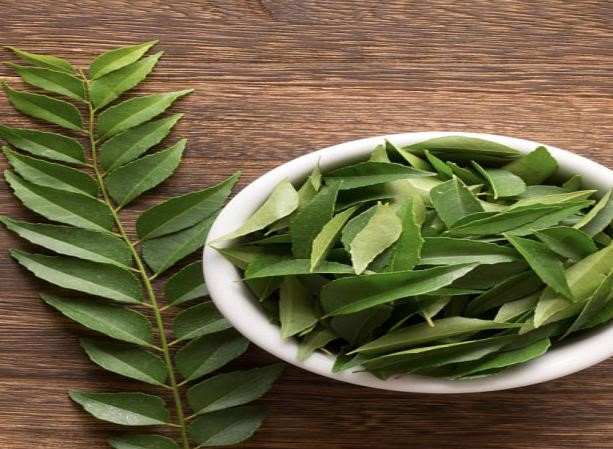
Figure 05-curry leaves
Onion:
Synonyms:
Allium cepa, bulb onion, common onion
Biological source:
Onion is a widely cultivated vegetable belonging to the genus Allium in the family Amaryllidaceae.
Family:
Amaryllidaceae
Chemical constituents:
Onions contain various sulfur compounds like allyl propyl disulfide, diallyl disulfide, and diallyl trisulfide, as well as flavonoids, quercetin

Figure -06 onion
An onion is a bulbous vegetable with layers of papery skin, ranging in color from white to yellow to red. Its distinct aroma and pungent taste make it a versatile ingredient in various cuisines worldwide. When chopped, its layers release a compound that can induce tears in some people. Onions can be eaten raw, cooked, or pickled, adding flavor and depth to dishes such as soups, salads, and stir-fries.
METHOD OF PREPARATION-
- Collection of herbs required for hair oil preparation.
- Herbs are as follows –fenugreek, onion, curry leaves, Hibiscus, coconut oil, Flaxseed Oil, almond oil.
Quantity of herbs taken –
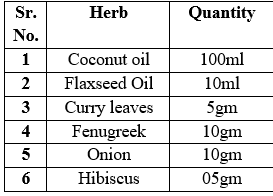
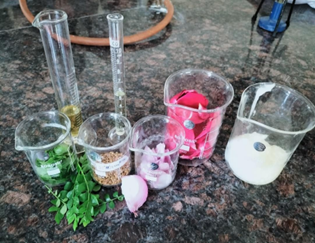
Figure 07 Figure-materials used.
- Take above herbs in given quantity.
- Add fenugreek, onion, curry leaves, hibiscus in grinder to make a fine paste
- In a beaker pour 10ml of coconut oil and heat on heating mental.
- Add the prepared mixture of all herbs in coconut oil.
- Boil the contents in coconut oil on heating mental for 15 min.
- Flax seed oil while boiling of herbs.
- During this process all the essential constituents of herbs get extracted form it.
- Direct boiling method is done here for extraction purpose.
- After 15min color of oil changes let this mixture cool.
- Filter the oil with the help of muslin cloth and collect the filtered oil.
- T The desired herbal hair oil is obtained through direct boiling method.
- Further evaluation parameters should be checked.
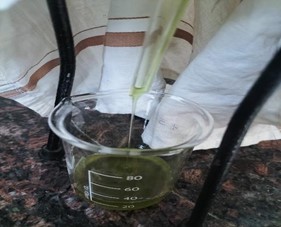
EVALUATION PARAMETERS –
- pH –
potential of hydrogen; a measure of the acidity or alkalinity of a solution equal to the common logarithm of the reciprocal of the concentration of hydrogen ions in moles per cubic decimetre of solution. Pure water has a pH of 7, acid solutions have a pH less than 7, and alkaline solutions a pH greater than 7.The hair pH value is 3.67, which is highly acidic. The scalp pH level is slightly higher at 5.5.
- Colour -
Yellowish brown
- Odor–
aromatic
- Sensitivity test–non sensitive
Skin irritation test–nonirritant
- Viscosity –
The viscosity of hair oil can vary depending on its ingredients and formulation. Generally, hair oils have a viscosity ranging from low to high, with some being more lightweight and easily spreadable, while others are thicker and more concentrated. It can range from around 50 to 1000 centipoise (cP) or even higher.
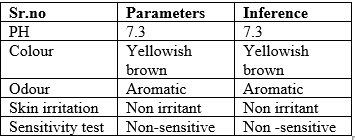
RESULT–
The prepared hair oil formulation is yellowish brown in color with pH in accordance with human skin neutral to slightly acidic.
CONCUSION–
This Research Aims to Formulate Hair Oil That Will Provide Sebaceous Gland All Nutrients That Are Required for Health Hair Growth Due to Which Regrowing of Hairs Will Increase and All Hair Related Problems Will Get Reduced. This Hair Oil Stop Drying of Scalp & Hairs and Improve Its Condition, It Will Provide Moisture to Scalp, Make Hair Thicker & Healthier, Bring Shine and Glossy Appearance. Problems Like Alopecia, Baldness, Hair Problems Caused Due to Mental Stress and Work Load, All Such Issues That Affect Hair Growth Will Be Reduced by This Hair Oil
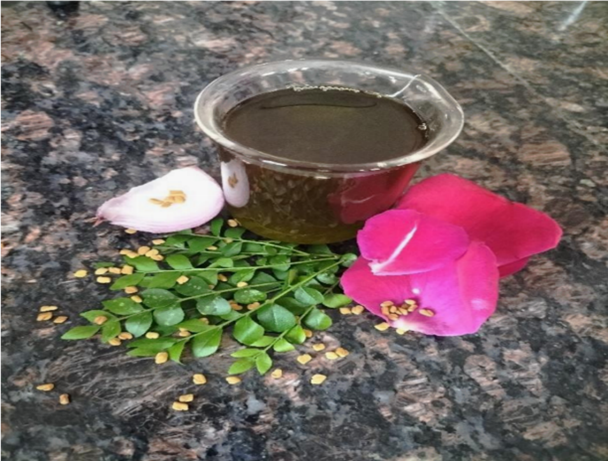
REFERENCES:
- K.Sudhirkumar,S.Gomathi,SSitaramSwamay,Internationaljournalofadvanceresearchin medical & pharmaceutical sciences, volume 1, 2016
- Mahavirchhajed,Priteshpaliwal,sumitDwivedi,Internationaljournalofpharmacyandlife sciences, volume 11, 2020.
- NSYamani,Sudha,Jyotsna,KPratyusha,Kartheeka,Journalofpharmacogoncyand phytochemistry, pg 3254, 2018
- T.UshaKiranReddy,G.Sindhu,S.Rajesh,B.Aruna,K.S.SandhyaRani,IndoAmerican journal of pharmaceutical sciences, pg 1540, 2017
- Md shahinoor rahaman dulal, hasib shaikh, mohammad abu taher, mohammad Sayeed ur rehaman,zakiarahaman,M.A.malek,internationaljournalofpharmaceuticalssciencesand research, volume 5, pg 1801, 2014
- K.D.Mali,R.M.Shroff,S.D.Chaudhari,S.S.Bacchav,IndoAmericanjournalof pharmaceutical research, pg 8041, 2017
- KolheShilpa,indorepranaya,shewaleShweta,polakshata,hanmanteleena,journalofdrug delivery and therapeutics, pg 387, 2019
- Sapnagupta,SumeetDwivedi,kushagraDubey,Hemantjoshi,Formulationandevaluationof herbal hair oil.
- Rahathunnisabegum,afzalunnisabegaum,preparationandevaluationofherbalhairoil,volume 6
- Pushpendrakumarjain,debajyotidas,Puneetjain,Internationjournalofpharmatechresearch, volume 9
- PoojaSBanerjee,meghasharma,rajeshkumarneema,journalofchemicalandpharmaceutical research, 2009
- AshiwnipJadhav,Deepakmorale,Abhijeetdaundekar,NikhilBhujbal, Dr Sandeep kshirsagar.


 Supriya Siddharth waghmare *
Supriya Siddharth waghmare *
 Namrata nitin Haladkar
Namrata nitin Haladkar











 10.5281/zenodo.12065091
10.5281/zenodo.12065091